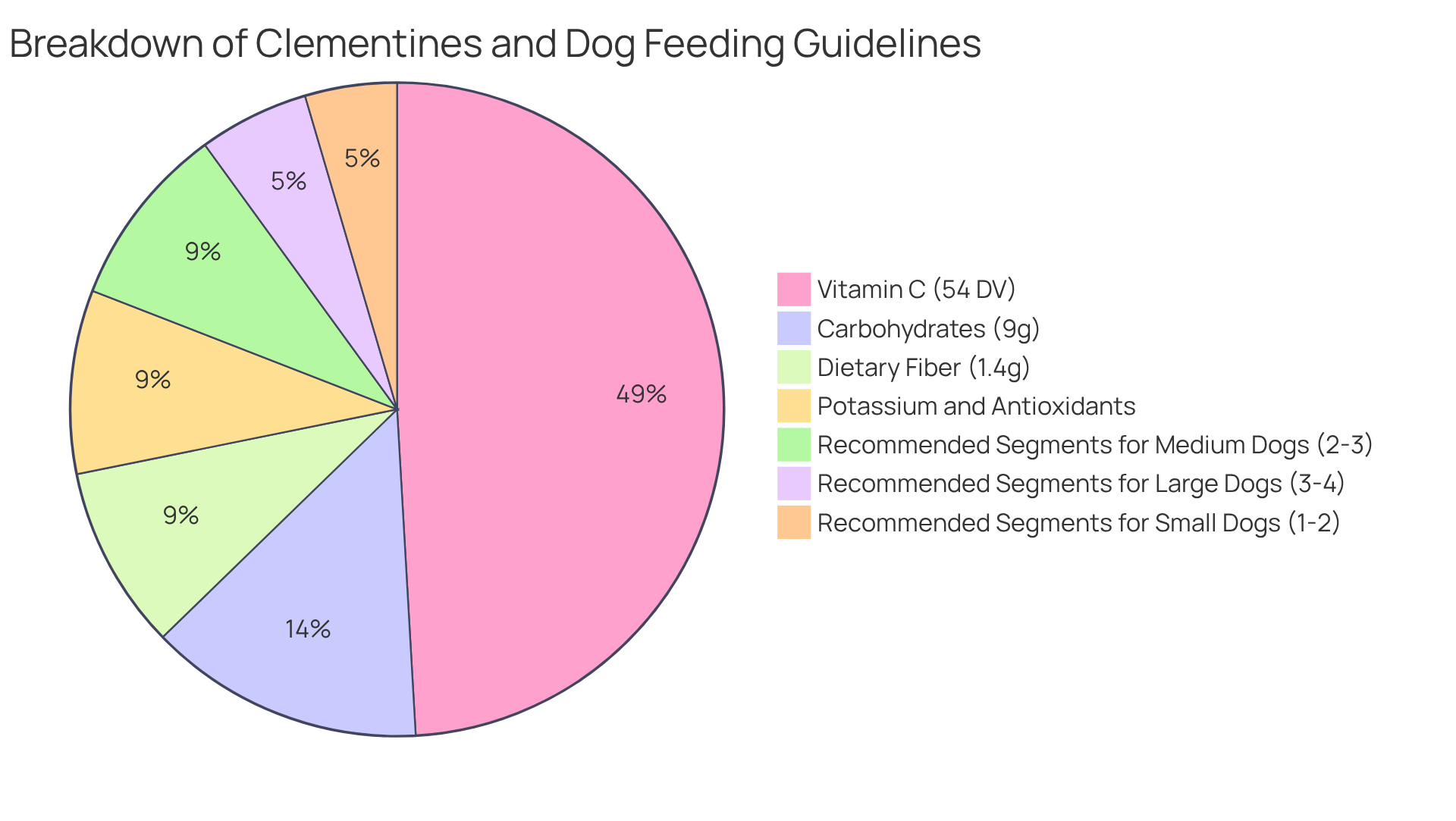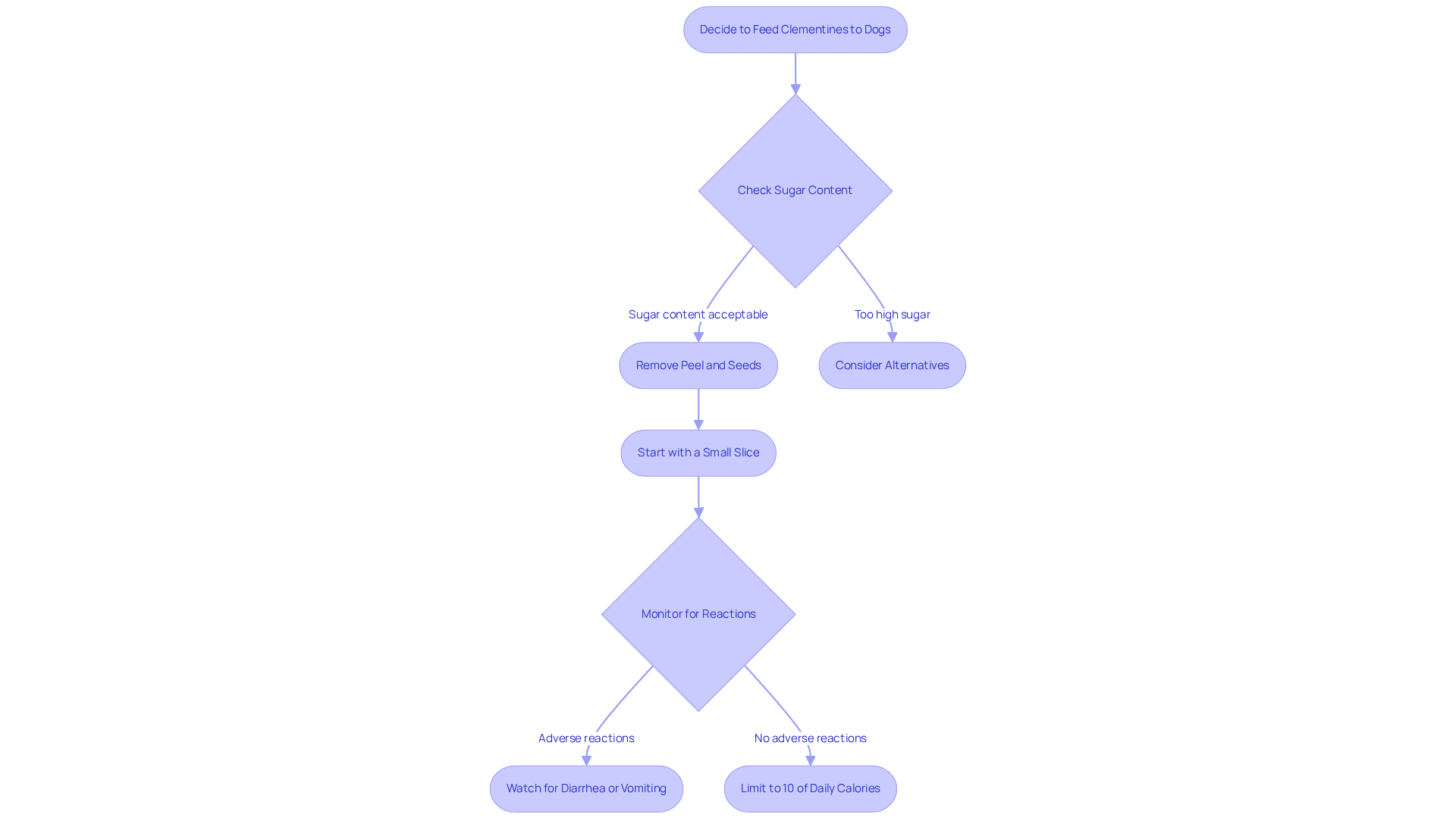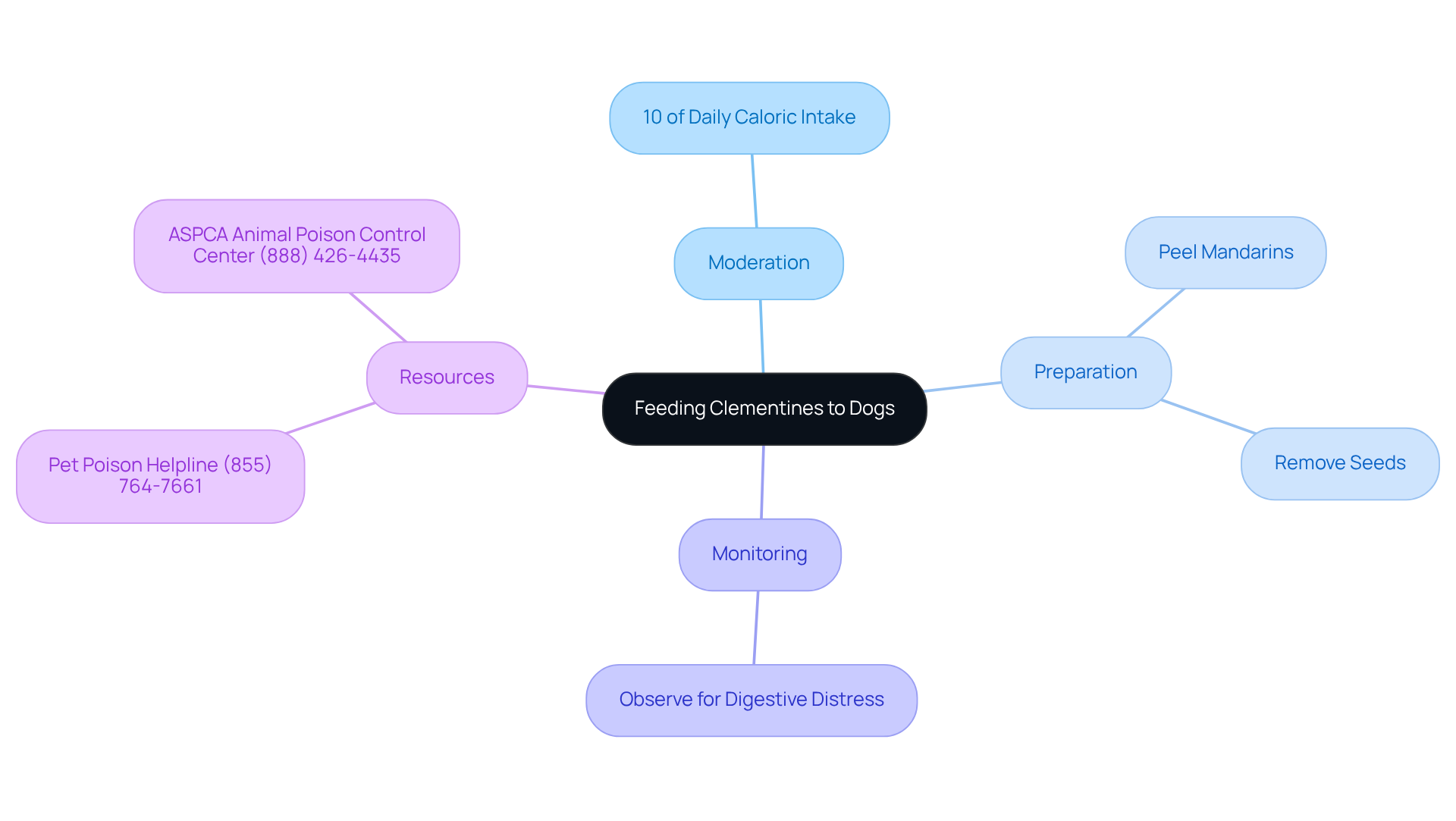Can Dogs Eat Clementines? Understanding Their Benefits and Risks
Overview
As a loving pet owner, you may wonder if your furry family members can enjoy clementines. The good news is that dogs can eat clementines in moderation! These delightful fruits offer health benefits, including hydration, vitamin C, and dietary fiber, which can contribute positively to your dog’s well-being.
However, it’s essential to be mindful of the high sugar content and acidity found in clementines. These factors may lead to gastrointestinal upset in some dogs, so proper preparation and portion control are crucial. By taking these precautions, you can ensure a safe and enjoyable treat for your beloved pet.
At Adventure Den, we understand the importance of nurturing your pet’s health while providing them with tasty treats. Always remember to introduce any new food slowly and in small amounts, keeping a close eye on how your dog reacts. This way, you can create a positive and safe eating experience for your furry companion.
Introduction
Clementines, those sweet and juicy citrus fruits, are often a favorite among humans. But what about our beloved canine companions? As pet owners, we always strive to enhance our furry family members’ diets with nutritious treats, leading us to the important question: Can dogs safely enjoy clementines?
This article explores the potential benefits these delightful fruits offer, such as:
- A boost in vitamin C
- Hydration
However, it’s essential to consider the risks associated with their high sugar content and acidity. Can these tasty snacks be a healthy addition to a dog’s diet, or do they hide potential dangers? Understanding the balance between enjoyment and safety is crucial for any responsible pet owner, and we’re here to guide you through it.
Define Clementines and Their Nutritional Value
Clementines are delightful small citrus fruits from the mandarin orange family, cherished for their sweet flavor, easy-to-peel skin, and seedless segments. If you’re looking to treat your furry family members, you might be wondering can dogs eat clementines, as these little oranges are not only a tasty snack but also pack a nutritional punch. Each fruit offers about 48 mg of vitamin C—roughly 54% of the daily value for humans—along with approximately 9 grams of carbohydrates and 1.4 grams of dietary fiber, which can be beneficial for digestive health.
Moreover, clementines provide a good source of potassium and antioxidants, contributing to overall well-being. With a high water content of about 86.58 grams per fruit, they can help keep your pets hydrated, making them a superb choice, especially during warmer months. However, it’s important to approach the topic of can dogs eat clementines with care. While these citrus fruits can be a healthy addition to your pet’s diet, it’s essential to ask can dogs eat clementines, and moderation is key. Pet owners should be mindful of their sugar levels and watch for any negative reactions, particularly in dogs with sensitive stomachs or diabetes.
According to the case study ‘Risks of Feeding These Fruits to Dogs,’ the question of can dogs eat clementines is important to consider due to their high sugar content and acidic nature. To ensure safety and enjoyment for your canine companions, proper preparation is essential. This includes washing, peeling, and removing any seeds. Remember, before asking can dogs eat clementines, know that they are not harmful to dogs when given in moderation. For portion control, consider these guidelines:
- Small breeds can enjoy 1-2 segments
- Medium breeds 2-3 segments
- Large breeds 3-4 segments per day
This way, you can ensure that treats do not exceed 10% of their daily calorie intake, keeping your beloved pets happy and healthy.

Explore the Benefits of Clementines for Dogs
Many pet owners wonder if can dogs eat clementines, which offer a wealth of health benefits for your furry family members, largely thanks to their high vitamin C content. This essential vitamin plays a crucial role in supporting the immune system, helping to fend off common illnesses. It’s also vital for maintaining healthy skin and overall vitality. Additionally, these delightful little oranges are packed with antioxidants that combat oxidative stress, enhancing your pet’s well-being by neutralizing harmful free radicals in their body. Plus, the dietary fiber found in these fruits aids digestion, promoting a healthy gut and preventing gastrointestinal issues.
During those warmer months, the elevated water content in clementines becomes especially beneficial, helping to keep your pets hydrated and cool. When given as an occasional treat, these citrus fruits can enrich your dog’s diet without significantly increasing calorie intake, as they contain just 47 calories per 100 grams. This makes them a low-calorie alternative to many commercial dog treats. However, moderation is key; small canines (under 20 lbs) should enjoy 1-2 segments, medium canines (21-50 lbs) can have 2-3 segments, and large canines (51+ lbs) may savor 3-4 segments of mandarins each day. Remember, excessive consumption can lead to digestive upset due to the fruit’s acidity.
To ensure safe enjoyment of mandarins, wash the fruit thoroughly, remove the peel and seeds, and offer them in small pieces. It’s also wise to be mindful that some dogs may have allergic reactions to citrus fruits, so keep an eye out for any signs of discomfort when introducing these treats into their diet. Overall, when prepared safely, you may wonder can dogs eat clementines, as they can be a nutritious addition to your dog’s diet, providing essential vitamins and hydration that contribute to their happiness and health.

Identify Risks and Precautions When Feeding Clementines to Dogs
Clementines can be a delightful treat for your furry family members, but as a loving pet owner, you should consider whether can dogs eat clementines. With a high sugar content—approximately 8.2 grams of carbohydrates and 8.2 grams of sugar per 100 grams—these fruits can contribute to weight gain and dental issues if consumed excessively. Additionally, the acidity of clementines might lead to gastrointestinal upset, prompting the inquiry of can dogs eat clementines, as it can manifest as diarrhea or vomiting in sensitive dogs.
To keep your pets safe, always eliminate the peel and any seeds before offering this fruit. These sections can be hard to digest and may pose choking hazards. When introducing mandarins, start slowly with just a single slice to monitor for any adverse reactions. When considering if can dogs eat clementines, it’s advisable to restrict citrus fruits to no more than 10% of your dog’s daily calorie intake, ensuring a balanced diet while allowing for occasional tasty treats.
Mandarins also provide 1.4 grams of fiber per 100 grams, which can assist in digestion, making them a beneficial addition to your pet’s diet. By following these precautions, you can safely include mandarins, offering hydration and vital nutrients without jeopardizing their health. Remember, there are other nutritious snack options like apples and bananas that can also delight your pets. Together, we can create a nurturing environment for your beloved companions.

Summarize Key Considerations for Feeding Clementines to Dogs
When considering giving mandarins to your furry family members, it’s essential to practice moderation. These fruits can serve as a nutritious treat, yet they should never replace a balanced diet. Always ensure to peel the mandarins and remove any seeds before offering them to your dog. It’s important to observe your pet for any signs of digestive distress after introducing citrus fruits, such as diarrhea or vomiting. Should any adverse reactions occur, please consult a veterinarian promptly.
Resources like the Pet Poison Helpline at (855) 764-7661 or the ASPCA’s Animal Poison Control Center at (888) 426-4435 are available for assistance. Remember, snacks should not surpass 10% of your dog’s daily caloric intake, ensuring that their main diet remains nutritious and balanced. By following these guidelines, you can safely enjoy the benefits of clementines as an occasional treat for your beloved companions, while also considering whether can dogs eat clementines.

Conclusion
Clementines can be a delightful addition to your furry family member’s diet, offering a range of nutritional benefits when given in moderation. These small citrus fruits not only provide hydration but also essential vitamins and antioxidants that can enhance your pet’s overall health. However, understanding the balance between benefits and potential risks is crucial for ensuring your beloved companion enjoys these treats safely.
When introducing clementines to your dog’s diet, moderation is key. With their high vitamin C content, these fruits can support your dog’s immune system and promote digestive health. Nevertheless, it’s important to remain vigilant about the sugar content and acidity of clementines, which may lead to digestive issues if consumed excessively. Proper preparation—such as peeling and removing seeds—along with adhering to portion guidelines based on your dog’s size, is essential for a safe and enjoyable experience.
Ultimately, the decision to include clementines in your dog’s diet should be made with care and consideration. By following the outlined precautions and monitoring your pet’s reaction, clementines can serve as a refreshing and nutritious treat. Embracing a balanced approach to your dog’s diet, which includes a variety of healthy snacks, will contribute to their well-being and happiness. Remember, nurturing your pet’s health is a journey best taken together.
Frequently Asked Questions
What are clementines?
Clementines are small citrus fruits from the mandarin orange family, known for their sweet flavor, easy-to-peel skin, and seedless segments.
What nutritional benefits do clementines offer?
Each clementine contains about 48 mg of vitamin C, around 9 grams of carbohydrates, 1.4 grams of dietary fiber, potassium, antioxidants, and has a high water content of approximately 86.58 grams.
Can dogs eat clementines?
Yes, dogs can eat clementines in moderation, but pet owners should be cautious due to their high sugar content and acidic nature.
What precautions should be taken when feeding clementines to dogs?
It is important to wash, peel, and remove any seeds from clementines before feeding them to dogs. Additionally, monitor for any negative reactions, especially in dogs with sensitive stomachs or diabetes.
How much clementine can I give my dog based on their size?
Small breeds can have 1-2 segments, medium breeds can have 2-3 segments, and large breeds can have 3-4 segments per day, ensuring that treats do not exceed 10% of their daily calorie intake.
Why is moderation important when feeding clementines to dogs?
Moderation is key because clementines have a high sugar content, and excessive consumption can lead to health issues, particularly for dogs with certain health conditions.







